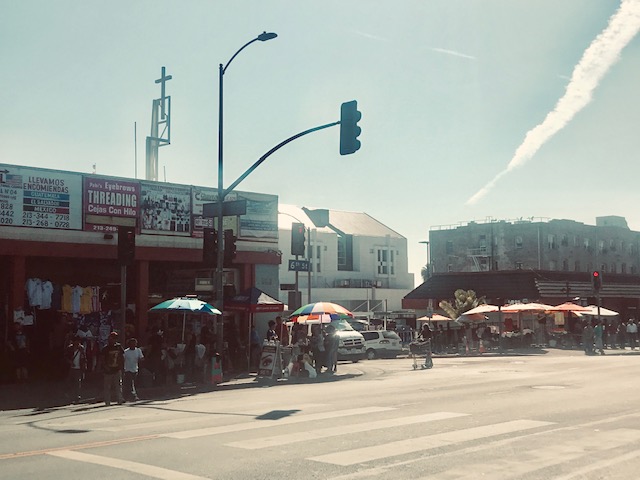Waves of Displacement: From Central America to Los Angeles | Adriana Cerón and Mildred Montesflores

Cover image: Westlake Theater on Alvarado, by Rebecca Dru
We met seventeen years ago in the patio of our twenty-three townhouse unit in the Westlake District of Los Angeles. Our friendship started through playing freeze tag, riding our bikes around the city, and racing one another to Doña Mari’s apartment to buy chips and soda. Her home was like stepping into a miniature version of a bodega. Doña Mari wore many hats: she was the neighborhood grandma, our babysitter, the soda lady, but above all, she was the soul of our community. Sadly, her death this past Spring went hand-in-hand with the death of our neighborhood as we once knew it.
Growing up, our community was composed of a language and culture that united us all. We understood one another because our neighbors shared similar stories of migration. For example, our families are Central American immigrants who migrated from El Salvador and Guatemala to the Westlake/Pico-Union District. Starting in the 1980s, this district, located in Downtown Los Angeles, was transformed spatially and culturally by Mexican and Central American immigrants who became a prominent presence in the area. For many Central Americans, Westlake became their first home after having to cross multiple international borders due to U.S.-fueled wars and genocide, military-controlled governments, natural disasters, and economic upheavals in their countries of origin. Families were separated and driven from their homes, including indigenous peoples in Guatemala who continue to be forcibly displaced from their lands to make way for large-scale farming, mining, and hydroelectric projects.
As we have grown older, we have walked through Downtown Los Angeles, speaking at length about the unfamiliarity of spaces that now cater to a white upper-middle-class population, but which were originally inhabited by working-class Latin American immigrants. We remain neighbors, even though the exterior elements of our community have changed. Investors who have attempted to bribe us with money to vacate our homes have failed. As Central American immigrants, we cannot help but remember that our parents experienced displacement from their homelands, fleeing from violence both physically and mentally. Yet, after creating a home in Los Angeles, we continue to face different layers of displacement, such as the fear of being evicted due to the continuous process of gentrification.
The term ‘gentrification’ was first coined in 1964 by sociologist Ruth Glass to describe the displacement of working-class families in London attributed to the rising middle-class. Glass viewed urban renewal projects, such as infrastructural transformations, as enabling gentrification, whereas other scholars, such as Gina Pérez, describe urban renewal as a “precursor to gentrification, not gentrification itself.” In her book, The Near Northwest Side Story (California, 2004), Pérez meticulously notes that gentrification is:
“[...] an economic and social process whereby private capital (real estate firms, developers) and individual homeowners and renters invest in fiscally neglected neighborhoods through housing rehabilitation, loft conversions, and the construction of new housing stock. Unlike urban-renewal, gentrification is a gradual process occurring one building or block at a time, slowly reconfiguring the neighborhood landscape of consumption and residence by displacing poor and working-class residents unable to afford to live in ‘revitalized’ neighborhoods with rising rents, property taxes, and new businesses to an upscale clientele.”
Pérez’s standpoint adequately explains the ongoing alterations happening in the Westlake-Pico Union District. Real estate developers have pinpointed it as a hot market for development. Buildings are being torn and replaced with luxurious apartments that local families can only walk by, but cannot afford, ultimately, uprooting families from the communities they once helped shape. Whole Foods, bistros, and vegan cafes- just to name a few- have also made their way into our neighborhood.
Prior to these curated establishments, most of the Westlake-Pico Union District brought the community together through home-cooked meals sold in shopping carts on 6th Street. Working-class Latin American immigrants helped enrich the cultural life of the region, with street vendors at the forefront of this trend. They relied on their hands, imagination, and memory to create makeshift kitchens on shopping carts to prepare plates full of nostalgia and memory of place, constructing new “urban cultural landscapes.” Immigrant entrepreneurs who opened Central American restaurants, bakeries, markets, and pupusa stands unearthed a sense of solidarity and connection amongst the Central American diaspora and strengthened the residential and commercial area of Westlake.
Westlake is identified as the enclave and center of Central American settlement in the United States-- a community that reminds us of our history and culture, and helps fortify our ethnoracial identity. The senses are sharpened when walking through MacArthur Park by the captivating smell of yuca frita and the ears prickle listening to ongoing Central American voseo. For 1.5 and second-generation immigrant youth, the diaspora is a remembrance of a home they once knew but cannot completely recall and a bittersweet glimpse of a history lived by their parents. The transformations are not just physical and make us wonder and worry that our culture will be completely obliterated, and that future generations will be deprived of witnessing their history and culture.
Two years ago, a private equity firm bought our apartment complex, and the months that followed were full of confusion and fear. Our parents feared that our livelihoods would change drastically, and often checked the front door to see if we received a notice from the firm notifying us to relocate. Private equity firms are infamous for “acquiring properties, making upgrades, and then seeking higher paying renters” and “[displacing] low-income families to try to bring in wealthier tenants to pay...higher rent.” We received paperwork that renovation work needed to be done on the roof and foundation of our apartments, as well as small cosmetic upgrades like adding a ceiling fan and patching holes in the walls. The city approved these “renovations,” which meant that our rent would increase and that we would not have running water nor gas from 8 am to 5 pm for the coming months due to construction. We received knocks on our doors from a young, white man speaking broken Spanish, letting us know that the alternative would be to move out before renovations started and that we would be monetarily “compensated.” We had 60 days to make up our minds. An attempt was made to gather our neighbors to make an appeal and stand up for our rights. However, because most of us were afraid of the repercussions and nervous that the firm would find any reason to evict us, the attempt was unsuccessful. Their intimidation tactic resulted in a domino effect and, little by little, most of the neighbors we grew up with ended up leaving the city.
The Eviction Lab explains that an eviction happens when a “landlord expels people from property he or she owns.” As a result, evictions diminish one’s chances of securing affordable housing, leads to increased homelessness and increased residential displacement amongst families. According to sociologist Matthew Desmond, most poor families who rent their homes spend at least half of their income on housing, with 1 in 4 of those families spending 70% of their total income on rent and utilities. In Los Angeles County alone, the yearly median income is $64,300, while in the Westlake District it is a mere $26,000. Furthermore, women, particularly from Black and Latinx working-class neighborhoods, are evicted at disproportionately higher rates in comparison to their male counterparts. Women are more susceptible to housing evictions for a myriad of reasons, such as earning lower wages in comparison to males from the same neighborhood. Single mothers may also face specific challenges like making ends meet and dealing with landlords who are hyper-vigilant towards children of color. In high-poverty Black neighborhoods, 1 in 33 males and 1 in 17 women are evicted, while in high-poverty White neighborhoods the ratio is 1:134 for men and 1:150 for women. Desmond further argues that the data presented above only accounts for court-ordered evictions and does not reflect “informal” evictions, such as paying unwanted tenants to move—also known as ‘cash for keys’—and using intimidation as a tactic for removal.
Our memories of childhood and community are deeply tied to our upbringing in the Westlake District. We have flourished here, and yet, to hear our home being spoken of as a disposable commodity has caused deep frustration and a lot of anger. Gentrification is not only affecting us in Los Angeles, but it is also affecting various impoverished communities around the United States, and globally. Rent strikes around Los Angeles have brought many together who are confronting this issue to stand up not only for our communities, but also to shed light on a symptom of neo-colonialism. These waves of displacement are all too familiar to our parents who crossed borders to find a home in the United States. The tide may grow stronger, but what we have learned throughout history is that displacement cannot beat imagination nor the willpower of immigrants. In a sea full of disregard, we have learned to become the stronger current, and assist those around us. Migrant Roots Media has provided us with the space and support to critically analyze our own experiences at the intersection of class conflict, housing insecurity, and displacement as well as the opportunity to unearth our history and culture in a way that fosters bravery and resistance.
This article was co-authored by Adriana Cerón and Mildred Montesflores.
Mildred Montesflores graduated from San Francisco State University with a B.A. in English Literature. She is interested in discovering and writing about Latinos to amplify and represent their voices, stories, and narratives in literature.
Adriana Cerón (she/her) recently graduated from Pitzer College with a BA in sociology and a minor in Chicano/a-Latino/a Studies. She is a Mellon Mays Undergraduate Fellow interested in the integration, attainment, and mobility of Latinos in the U.S., with a particular focus on U.S. Central Americans. Adriana was born in El Salvador and at the age of five migrated to Los Angeles, CA, where she has lived since.









